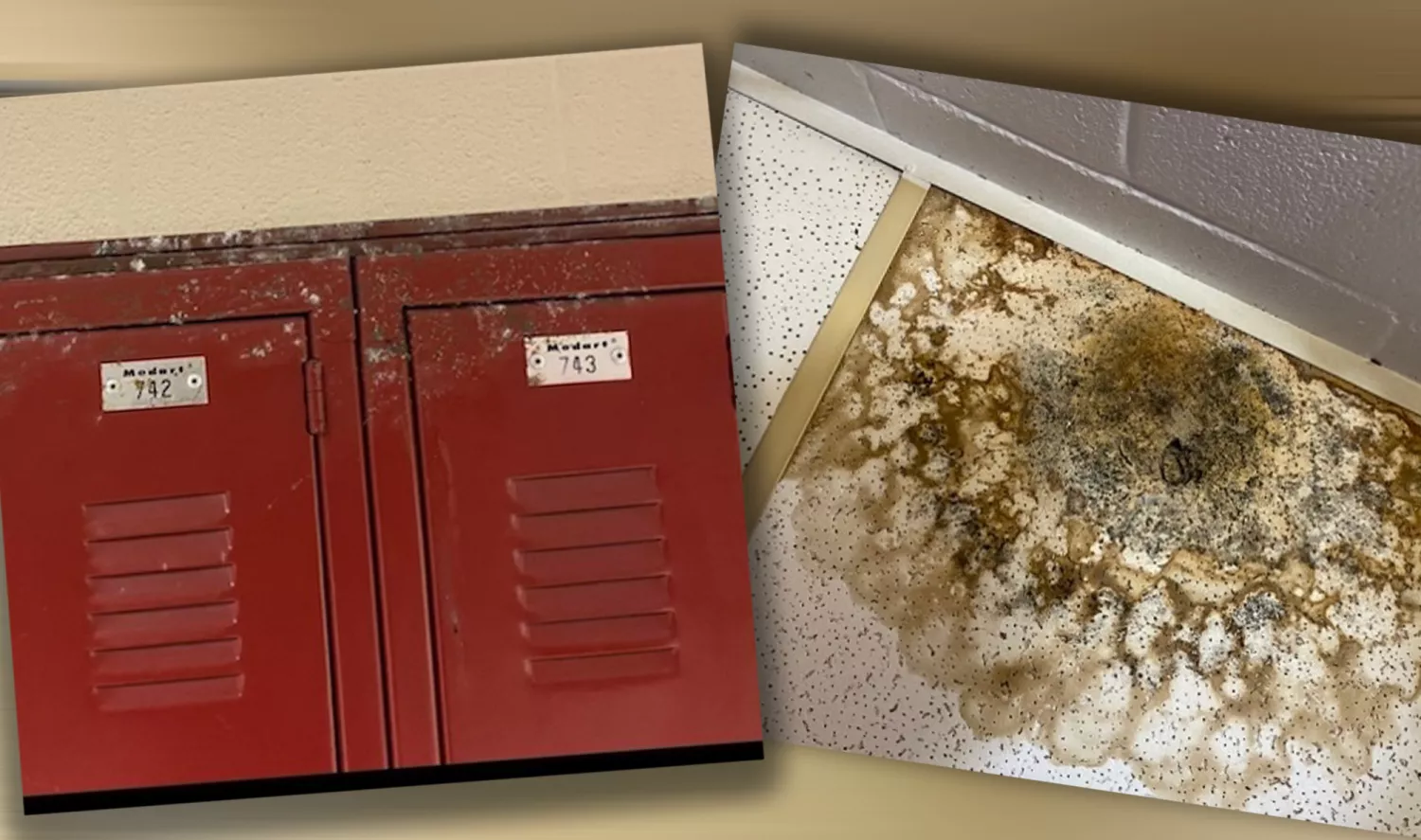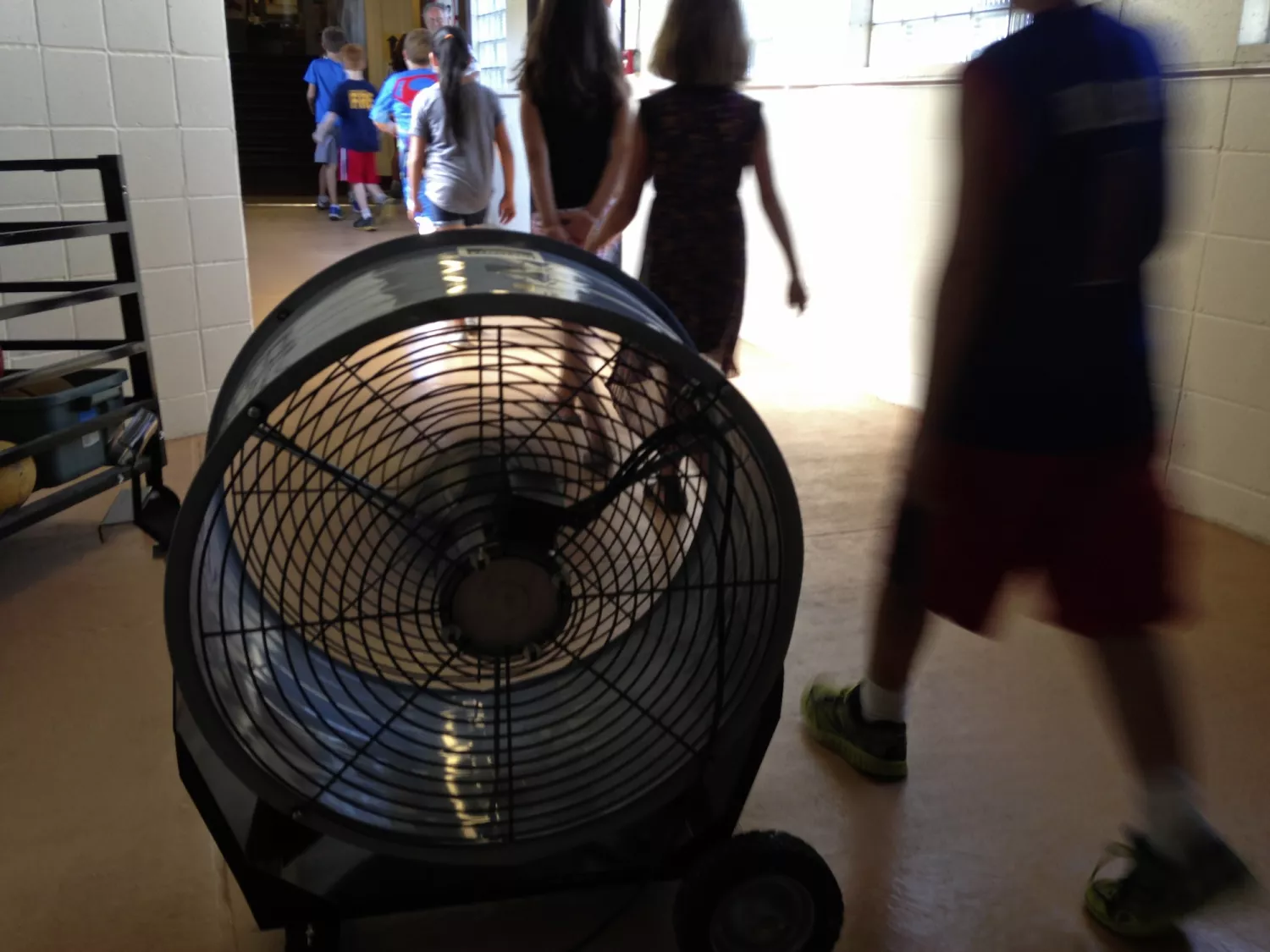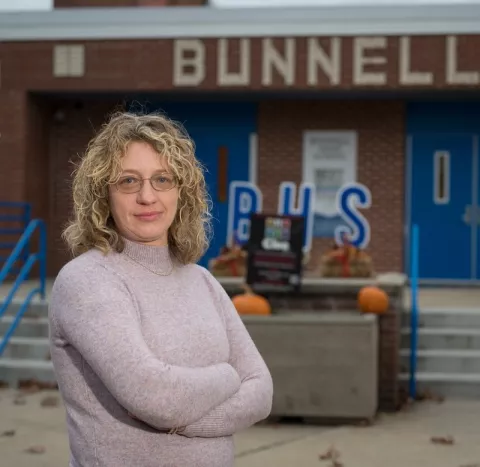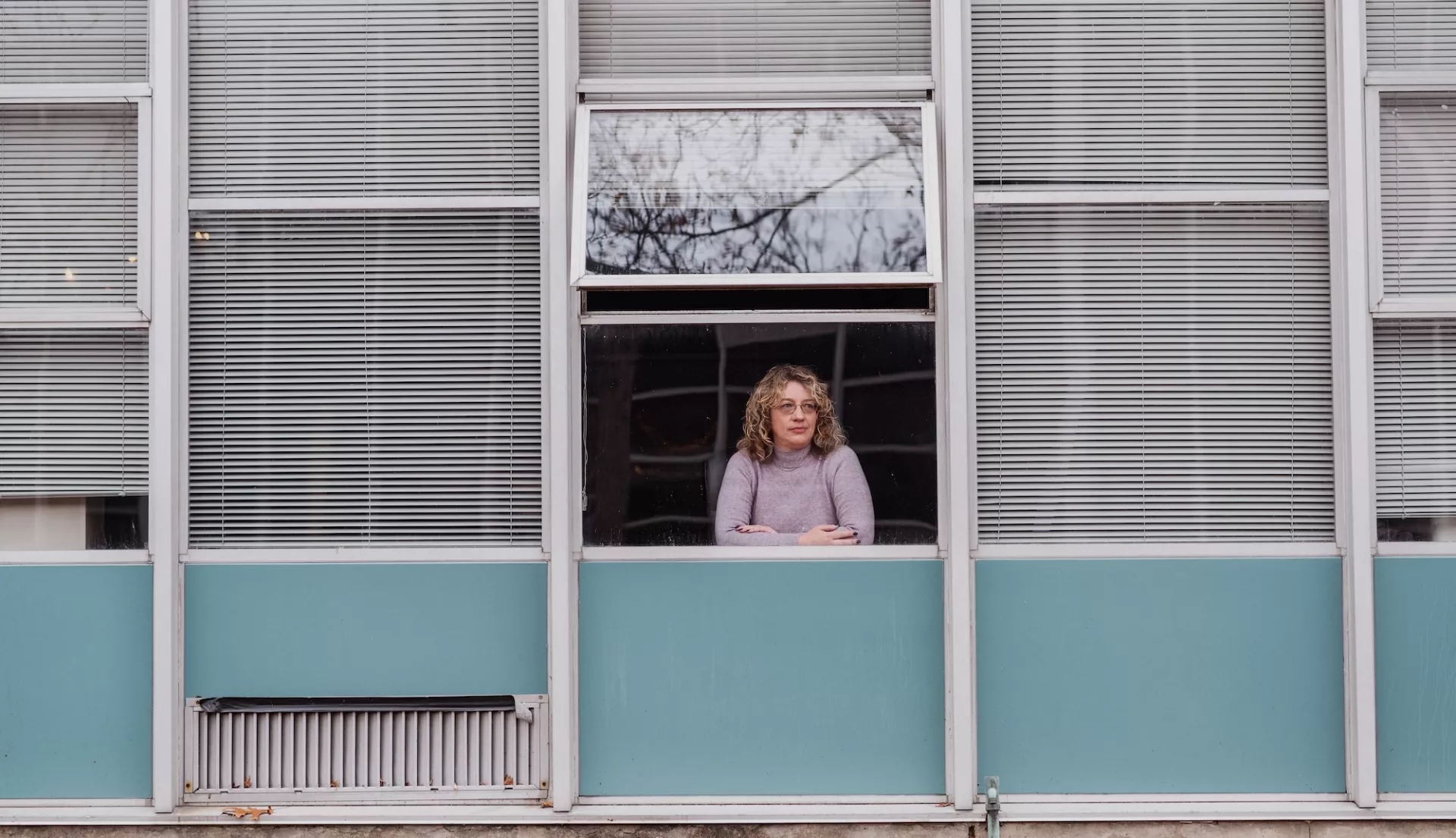Key Takeaways
- More educators and students are teaching, working and learning in school buildings that are harmful to their health, reporting respiratory problems, headaches, nausea, fatigue, and difficulty concentrating.
- Healthy and safe working conditions are a key factor in keeping educators in the profession.
- As many policymakers downplay the dangers of poor indoor air quality and extreme temperatures, educator advocacy has kept the issue in the public spotlight.
Anne Forrester began feeling ill during her first year of teaching, in 2016. The symptoms steadily worsened as she spent more time in her decades-old school building.
“I was getting sick all the time, including chronic respiratory and asthma symptoms,” says Forrester, who worked in Thomas C. Boushall Middle School, in Richmond, Va., at the time. “But I was new and didn’t think too much about it.”
There were, however, whispers in the building about what was really triggering these symptoms—which were also affecting many of Forrester’s colleagues and students.
It turned out that many buildings across the district were becoming breeding grounds for mold.
By 2022, says Forrester, “you could see it everywhere.” Mold was clearly visible in classrooms, hallways, and offices, covering parts of the ceiling floors, lockers, and chairs.
Mold is just one of the many pollutants that degrade indoor air quality (IAQ) in many school buildings. According to the Centers for Disease Control and Prevention, roughly half of the educators and students working and learning in school buildings are breathing air polluted by bacteria, chemicals, viruses, and pesticides.
When hot weather hits, conditions become even more dangerous. Long before the end of the school year, temperatures— fueled by climate change—are reaching 90 degrees, creating stifling, often unbearable learning and working conditions.
“When you have breathing issues or it’s too hot or too cold or too humid, you will not be productive,” says Kristen Record, a high school physics teacher in Stratford, Conn. “It is extremely hard to concentrate for lengthy periods of time.”

Several years ago, Record moved out of her office at Bunnell High School while workers removed the mold-infested carpet, relieving symptoms she had blamed on seasonal allergies.
When a clear health risk emerges, the response from districts is usually to close the school until some sort of repair or remediation can be completed— usually a temporary fix that buys a little time.
That is no longer acceptable, says Darrell Turner, a teacher at Martin Luther King Jr. Early Learning Center, in Richmond.
The dismal air quality at Turner’s previous school forced him to take his students outdoors for short breaks.
“We’re setting up our students for a lifetime of health issues,” he says. “If the buildings they’re learning in make them sick, it’s not creating a safe environment for them—or for us.”
A Lasting Impact on Students
A June 2020 report by the Government Accountability Office estimates that 41 percent of public school districts need to replace or update their heating, ventilation, and air conditioning (HVAC) systems in at least half of their schools—roughly 36,000 schools across the country.
School buildings have been neglected for too long, says Joseph G. Allen, director of Harvard University’s Healthy Buildings Program and associate professor at the Harvard T. H. Chan School of Public Health.
“When we think about education, we think about curriculum and teaching, and lunch and recess, and transportation and socialization,” Allen explains. “But the role of the school building is an afterthought. We know that good ventilation and filtration are key to student health, student thinking, and student performance.”
When schools began to reopen after the height of the pandemic, healthy indoor air quality and ventilation—essential to managing the risk of infectious disease—became one of educators’ most pressing concerns.
NEA successfully advocated for historic pandemic rescue funds that could be allocated to infrastructure investments. NEA also worked with affiliates and local leaders to document air quality hazards and demanded that they be remediated before schools reopened.
Over the past couple of years, NEA state affiliates and NEA school rescue fund coordinators have collaborated with school administrators to address poor IAQ by updating HVAC systems to improve ventilation.
In Albuquerque, N.M., public schools are replacing all HVAC units in 35 schools with new refrigerated air systems at a cost of over $16 million in relief funds.
Massachusetts has allocated $100 million in American Rescue Plan funds at the state level to improve and install HVAC systems in its schools.
More recently, however, as rising concerns over student learning, gun violence, and other issues have taken center stage, it’s become challenging to focus attention on the dire condition of school buildings.
“People, parents especially, will pay attention when schools actually have to close,” Record says. “But they are not tracing falling grades and misbehavior to issues around heating, cooling, HVAC, and mold.”
While these connections are not always easy to see, the physical and cognitive effects of poor indoor air quality and extreme temperatures are well established by research. A 2006 study found that when air quality improved in schools, student achievement increased on average by 8 percent.
A 2020 study revealed that students scored increasingly worse on standardized tests each school day where the temperature rose above 80 degrees. Furthermore, a recent study by Harvard University found that extreme temperatures exacerbate absenteeism and student disciplinary referrals.

Safe Buildings and Teacher Retention
Poor working conditions are also becoming a key factor in retaining educators. A recent teacher survey by the RAND Corporation found that pay increases alone—without improvements in hours worked or working conditions—are unlikely to improve teachers’ job satisfaction enough to reverse their intention to leave.
Indoor air quality and temperatures are critically important working conditions, along with class size, respect, support, and workload.
“Pay is the number one issue in Richmond,” Turner says. “But working conditions are right up there as well. And the safety of our buildings—this mold and heat—is one that we are concerned with.”
Forrester, who is vice president of the Richmond Education Association (REA), agrees: “Mold in our building and the health issues it has caused [won’t] do wonders for teacher retention.”
In 2022, as the school district downplayed the dangers posed by mold, Forrester transferred to a different school. Although there were other reasons she wanted to move—namely a desire to teach at the high school level—the mold problem at Boushall was a major factor.
“I'm Struggling to Breathe”
Elapsed time: 0:00
Total time: 0:00“Educators whose health is being affected will do the same,” Forrester says. “They don’t have to leave the profession, just their school or district. But it’s still a disruption for students.”
The disruption is more likely to be felt by students of color in high-poverty districts, where staff shortages can be more severe. Lack of professional pay and burnout are cited as top reasons for departures.
But the dismal condition of many school buildings in these communities—and the documented impact on student achievement and health— can only contribute to educators’ sense of frustration and helplessness.
When it Gets Too Hot
When a heat wave gripped the Pacific Northwest in May 2023, many students and educators in Federal Way Public Schools—a high-poverty district south of Seattle—sat in classrooms without air conditioning.
The district provided more fans, but educators were tasked with finding other ways to alleviate the heat. There was only so much they could do. The impact on students was alarming.

Sara Rowe, an office manager at Adelaide Elementary School, took care of students when no nurse was on duty. She saw students who were close to passing out, as well as some who suffered from nosebleeds, headaches, and anxiety.
“We had a young girl with a panic attack,” Rowe recalls. “The heat was making it feel as if the walls were closing in on her.”
Educators in Federal Way and across the country began posting photos on social media of classroom thermostats hitting 80 to 90 degrees, drawing attention to the oppressive conditions.
In 2022, Columbus, Ohio, educator Joe Decker purchased a large fan to try to mitigate classroom temperatures in excess of 90 degrees. Mifflin Middle School, where he teaches eighth grade, was one of many in his district without air conditioning.
“More than 90 percent of our students have free or reduced lunch,” he says. “Some of them are malnourished, and I can’t watch them become dehydrated. … I should not have to be thinking, ‘Do I need to call a Life Squad for one of my students?’”
Filling the Leadership Void
No national or state standards exist to govern how public schools should monitor, detect, and address air-quality problems, including heating and cooling. Then there’s the prohibitive cost of repairs or upgrades.
The result is often inaction or half measures on the part of school districts. The response from the Federal Way district during the 2023 heat wave was underwhelming. “We were told to think outside the box, be creative,” Rowe recalls. “We didn’t really feel supported.”
After the Federal Way Education Association sounded the alarm about extreme heat and poor air quality last spring, state lawmakers took notice. Educators hope to see a bill in next year’s legislative session that helps address these issues.
In 2018, the Connecticut Education Association (CEA) found that while the state had statutes governing temperature ranges in animal shelters, no such mandates existed for public school buildings.
That same year, Record co-led a CEA data collection drive that asked educators to record temperature and humidity levels of their classrooms into an online database.

In September, classroom temperatures regularly exceeded 85 degrees. A couple of months later, as winter approached, temperatures barely topped a chilly 55 degrees. The effort helped launch a CEA advocacy campaign. The union urged lawmakers to address air quality and extreme temperatures, direct pandemic relief funds to HVAC repair and installation, and secure additional grant funding.
“It’s all a work in progress,” Record says. “What we’re really focusing on is getting those funds into underserved communities, where the need for upgrades is more urgent.”
In Columbus, Decker and his colleagues used the power of collective bargaining. The Columbus Education Association’s successful three-day strike, in October 2022, led to a new contract that, among other highlights, won a guarantee that all student-learning areas will be climate-controlled no later than the start of the 2025 – 2026 school year—including the installation of HVAC units.
In Richmond, educators persuaded the district to conduct more mold testing, and REA lobbied the school board to establish criteria for maximum and minimum indoor temperatures and air quality standards.
Record says district leaders and lawmakers must acknowledge that when you close schools due to allergens or extreme temperatures, the problem has reached a crisis stage.
“Instead, we’re told to live with it,” she says. “We shouldn’t still be talking about this in 2023, and I have no doubt that if our state and local associations were not speaking up, no one else would be.”



